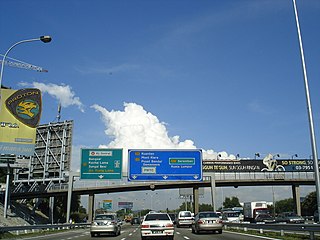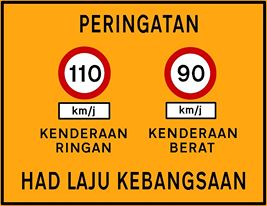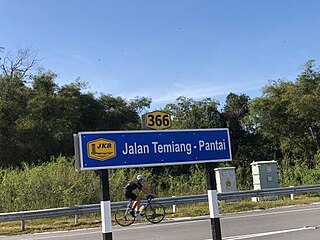
A vehicle registration plate, also known as a number plate, license plate, or licence plate, is a metal or plastic plate attached to a motor vehicle or trailer for official identification purposes. All countries require registration plates for road vehicles such as cars, trucks, and motorcycles. Whether they are required for other vehicles, such as bicycles, boats, or tractors, may vary by jurisdiction. The registration identifier is a numeric or alphanumeric ID that uniquely identifies the vehicle or vehicle owner within the issuing region's vehicle register. In some countries, the identifier is unique within the entire country, while in others it is unique within a state or province. Whether the identifier is associated with a vehicle or a person also varies by issuing agency. There are also electronic license plates.

A department of motor vehicles (DMV) is a government agency that administers motor vehicle registration and driver licensing. In countries with federal states such as in North America, these agencies are generally administered by subnational governments, while in unitary states such as many of those in Europe, DMVs are organized nationally by the central government.

The Ministry of Transportation (MTO) is the provincial ministry of the Government of Ontario that is responsible for transport infrastructure and related law in Ontario. The ministry traces its roots back over a century to the 1890s, when the province began training Provincial Road Building Instructors. In 1916, the Department of Public Highways of Ontario (DPHO) was formed and tasked with establishing a network of provincial highways. The first was designated in 1918, and by the summer of 1925, sixteen highways were numbered. In the mid-1920s, a new Department of Northern Development (DND) was created to manage infrastructure improvements in northern Ontario; it merged with the Department of Highways of Ontario (DHO) on April 1, 1937. In 1971, the Department of Highways took on responsibility for Communications and in 1972 was reorganized as the Ministry of Transportation and Communications (MTC), which then became the Ministry of Transportation in 1987.

Johor Bahru Inner Ring Road, (JBIRR) or Jalan Lingkaran Dalam, Federal Route 188, is a multi-lane federal ring road highway that circles the Johor Bahru Central District in Johor, Malaysia. The 4.6-kilometre (2.9 mi) highway was the most expensive road infrastructure project per kilometre of its time in the country.
VicRoads, or the Roads Corporation of Victoria, is a statutory corporation in the state of Victoria, Australia. In the state, it is responsible for driver licensing and vehicle registration, and regulating the accident towing industry in Victoria. It is part of the Department of Transport.

Malaysian registration plates are displayed at the front and rear of all private and commercial motorised vehicles in Malaysia, as required by law. The issuing of the number plates is regulated and administered by the Malaysian Road Transport Department or JPJ.

Malaysian Federal Roads System, is the main national road network in Malaysia. All Federal Roads in Malaysia are under the purview of the Ministry of Works (MOW). According to the Ministerial Functions Act 1969, the MOW is responsible to plan, build and maintain all Federal Roads gazetted under the Federal Roads Act 1959. However, most of the Federal roads' projects were built and maintained by the Malaysian Public Works Department (JKR), which is also one of the implementing agencies under the MOW.
The South Klang Valley Expressway, or SKVE, is an expressway in the southern part of Klang Valley, Malaysia's most densely populated region. This 51.7 km (32.1 mi) dual-carriageway provides links to the booming towns in southern Klang Valley, including the country's administrative capital, Putrajaya. South Klang Valley Expressway is the fifth east–west-oriented expressway in the Klang Valley after the Federal Highway, the New Klang Valley Expressway (NKVE), the Kuala Lumpur–Kuala Selangor Expressway (LATAR) and the Shah Alam Expressway (KESAS).

Road signs in Malaysia are standardised road signs similar to those used in Europe but with certain distinctions. Until the early 1980s, Malaysia closely followed Australian, Irish and Japanese practice in road sign design, with diamond-shaped warning signs and circular restrictive signs to regulate traffic. Signs usually use the FHWA Series fonts typeface also used in the United States, Canada, and Australia, as well as New Zealand, although some signs on recently completed expressways use Transport Heavy. However, the new format signs use a font specially designed for the Malaysian Highway Authority (LLM). The font is called LLM Lettering. It has two type of typefaces, LLM Narrow and LLM Normal.
Many countries have adopted a penalty point or demerit point system under which a person’s driving license is cancelled or suspended based on the number of points accumulated by them over a period of time because of the traffic offenses or infringements committed by them in that period. The demerit points schemes of each jurisdiction varies. These demerit schemes are usually in addition to fines or other penalties which may be imposed for a particular offence or infringement, or after a prescribed number of points have been accumulated.
Padang Jawa is a kampung and a suburb of Shah Alam, Selangor, Malaysia.

Had Laju Kebangsaan is a set of speed limits applicable on Malaysian expressways, federal roads, state roads and municipal roads. The National Speed Limits was enforced on 1 February 1989 following the National Speed Limit Orders 1989 (Perintah Had Laju Kebangsaan 1989). Like any other countries in the world, failing to obey the speed limit on Malaysian roads and expressways is an offence as subject to Malaysian Road Safety Act 1987, which can be fined up to RM300, depending on the difference between the speed limit and the driven speed.

The Transport Department of the Government of Hong Kong is a department of the civil service responsible for transportation-related policy in Hong Kong. The department is under the Transport and Logistics Bureau.

Driver licences in Australia refer to the official permit required for a person to legally drive a motor vehicle in Australia. The issue of driver licences, alongside the regulation and enforcement of road use, are all managed by state and territory governments.

The Malaysian Prison Department, is a department controlled by the Malaysian Minister of Home Affairs responsible for prisons where offenders sentenced by the courts are held. These jails also act as detention and recovery institutions.

A driving licence is required in Malaysia before a person is allowed to drive a motor vehicle of any description on a road in Malaysia under the Road Transport Act 1987, section 26(1). Under section 26(1) of the Road Transport Act, an individual must possess a valid driving licence before being permitted to drive on the road, or can be prosecuted under section 26(2). Upon conviction, the miscreant is liable to fines or jail or both. Driving licence holders are subject to all traffic rules stated in the Road Transport Act 1987.

The Malaysian Expressway System is a network of national controlled-access expressways in Malaysia that forms the primary backbone network of Malaysian national highways. The network begins with the Tanjung Malim–Slim River tolled road which was opened to traffic on 16 March 1966, later North–South Expressway (NSE), and is being substantially developed. Malaysian expressways are built by private companies under the supervision of the government highway authority, Malaysian Highway Authority.

The Ministry of Transport, abbreviated MOT, is a ministry of the Government of Malaysia that is responsible for transport: road transport, civil aviation, marine, road safety, port authority, railway assets, maritime, air accident investigation, logistic, maritime safety, shipping, rail transport, airport, airline.

The Urban Transformation Centre (UTC) is a public amenities centre located at some state capitals and urban areas in Malaysia. The rural counterpart of UTC is Rural Transformation Center(RTC).

Temiang–Pantai Highway or Malaysia Federal Route 366 is a federal route in Seremban, Negeri Sembilan, Malaysia. It is built to shorten amount of time for users from Kajang–Seremban Highway to Malaysia Federal Route 86 which connects Seremban to Kuala Klawang and Simpang Pertang.
















